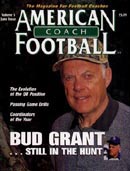Article CategoriesAFM Magazine
|
Techniques and Drills. Part One of a two-part series.For Teaching the Corner to Execute Selected Basic Coverages.by: Greg McMackin Defensive Coordinator, University of Hawaii © More from this issue JAM TECHNIQUE The Jam technique is one of the most important techniques a corner must master when his responsibility is to roll up to defend the flat or when it is a pass play, such as in two-deep zone. At the snap of the football, the corner's alignment should be five-to-six yards deep and head up on the receiver with his outside foot up. The defender's key should be the quarterback. If the quarterback comes straight down the line of scrimmage, as when running an option play, the corner will contain the football and take the pitch man on the option play. If the quarterback comes off the line of scrimmage, the cornerback will execute the "jam" technique. The corner will step up with his inside foot to parallel his stance. He focuses his eyes on the lower part of his opponent's jersey number. The defensiv....The full article can only be seen by subscribers.
|
|
|||||||
| HOME |
MAGAZINE |
SUBSCRIBE | ONLINE COLUMNISTS | COACHING VIDEOS |
Copyright 2025, AmericanFootballMonthly.com
All Rights Reserved





